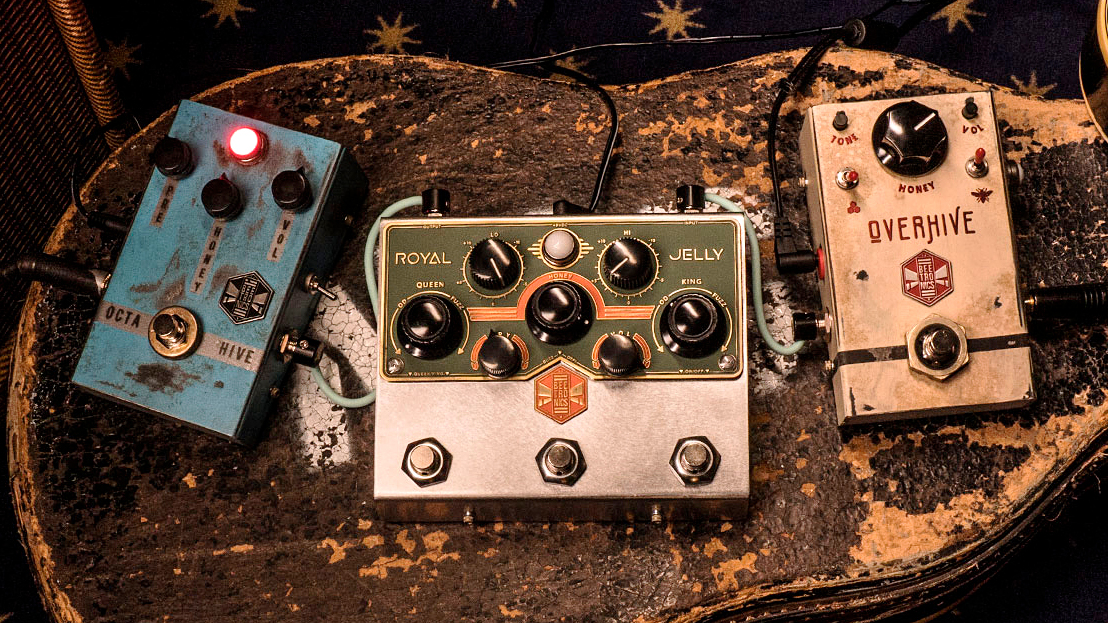
From his hive of activity in Los Angeles, the Beetronics founder talks about what keeps his buzz going in today’s pedal world...
1. What was the first pedal you built and how did the design come about?
“My brother and I owned a recording studio in Brazil before we moved to the US. We moved here about 10 years ago after my band signed to a label, and the studio we recorded in had a repair tech. I said, ‘We really need to start learning this stuff, because it’s hard to find these guys back home.’ A good entry point was making pedals and the very first pedal I built was a Colorsound Overdriver [clone]. I went on to design my own circuits and the first two Beetronics pedals were the OctaHive [high octave fuzz] and the WhoctaHell [low octave overdrive/fuzz].”
2. What do you think makes Beetronics unique?
We knew the sounds we liked and what we wanted, and that shaped the whole thing. It’s been a very natural progression
“I’ve been a professional musician since I was 17 and my brother is a recording engineer at a studio here in North Hollywood. We knew the sounds we liked and what we wanted, and that shaped the whole thing. It’s been a very natural progression. The name of the brand comes from my nickname abelha, which means ‘bee’ [in Portuguese].”
3. What’s your best-selling pedal and why do you think that is?
“The Royal Jelly. It’s a collaboration with [Electro-Harmonix/Pigtronix/Xvive designer] Howard Davis. It’s very versatile - and very unique. You get an overdrive and a fuzz, and you can blend between them. And you can blend in the dry signal. You can really do a lot with that pedal. People even use it on drums!”
Get the MusicRadar Newsletter
Want all the hottest music and gear news, reviews, deals, features and more, direct to your inbox? Sign up here.
4. Is there anything new on the horizon with Beetronics?
“Right now, I’m trying to get the Swarm [PLL fuzz/harmonizer] out. People are very excited about it from the last NAMM show and we have a lot on pre-order. It has a straight up, powerful-sounding fuzz tone and two harmonies - one below and one higher. You can select nine different pitches and then there’s the frequency modulator. It’s all very interactive. As extreme as it is, it’s pretty versatile and you can make a lot of different sounds with it.”
5. Tell us a secret about effects that you’ve discovered...
“Try using overdrive before fuzz. It can get a little less crazy - sometimes you don’t get as much of the harsh high-end and the sound becomes more controllable.”

6. What’s your best tone tip?
“Keep it simple. There is a huge pedal culture, but, in my personal opinion, if you add too much stuff it can start getting in the way. I recently did some gigs with just the Royal Jelly and the Tonal Recall RKM from Chase Bliss [Audio] and it sounded amazing. It was just as good a sound as I can get with my bigger ’board. Don’t let things get in the way of your playing. Keeping it simple is also an easy way for things not to go wrong!”
7. What new pedal triggers your GAS most now?
“I’m a big fan of the Chase Bliss stuff. The Tonal Recall RKM [analogue delay] is incredible. The only ones I don’t have yet are the Gravitas [tremolo] and Brothers [boost/overdrive/fuzz]. A few years ago, I went to the NAMM show and met Joel [Korte, Chase Bliss owner]. At that point, I had never heard of Chase Bliss, but now I honestly think Chase Bliss are the coolest pedals there are. I also really like Tru-Fi pedals. They’re really good recreations of vintage pedals. I have their [Zosa Fuzz] Tone Bender and [Floyd Fuzz] Big Muff.”
8. What pedals are on your own effects ’board?
A friend recently showed me a really cool old Fender pedal - the FDS-90 Distortion. It was made in Japan in the 80s by Maxon
“On my big experimental studio ’board I have a [Chase Bliss] Condor, Tonal Recall RKM, Warped Vinyl HiFi and Thermae. I have a DigiTech Whammy Ricochet, an Electro-Harmonix Pitch Fork, a Strymon Volante and a Tru-Fi Floyd Fuzz. I also have the Overhive, OctaHive, Royal Jelly, Swarm and Buzzter Beetronics pedals. That all goes through a Boss ES-5 [switching system].”
9. What’s your favourite vintage pedal and why?
“A friend recently showed me a really cool old Fender pedal - the FDS-90 Distortion. It was made in Japan in the 80s by Maxon, I think. Also, I really like the original [Maestro] Fuzz-Tone. There are some reissues, but I don’t think I’ve heard one that really sounds like the original.”
10. Are there any long-lost gems of the pedal world that you think would be worth reissuing?
“I would love to see a Binson Echorec reissue with a real drum and wire, like the originals. I saw something like that at NAMM a few years ago from T-Rex. That’s my all-time favourite piece of gear as far as effects go. Strymon released the Volante which captures that, but it’s DSP.”
Guitarist is the longest established UK guitar magazine, offering gear reviews, artist interviews, techniques lessons and loads more, in print, on tablet and on smartphones Digital: http://bit.ly/GuitaristiOS If you love guitars, you'll love Guitarist. Find us in print, on Newsstand for iPad, iPhone and other digital readers
“Instead of labouring over a perfect recreation, we decided to make an expanded counterpart”: Chase Bliss teams up with Mike Piera for Analog Man collab based on the legendary King Of Tone
“A pedal that sings with harmonic richness and blooming touch response”: Tone King offers up boutique tube amp tones for your pedalboard with the Imperial Preamp












